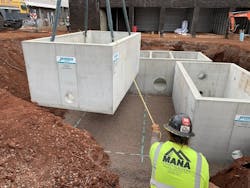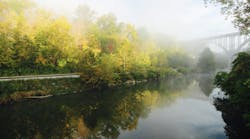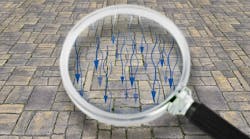About the author:
Robert Whitmore is principal at Precast Marketing Partners. He can be reached at [email protected].
Biofiltration may soon become as ubiquitous as catching a wave on the Hawaiian Island of Oahu. When it comes to managing storm water, Oahu has gone greener and cleaner since the city and county of Honolulu implemented revised “Rules Relating to Water Quality” to include new low impact development (LID) requirements.
“Rather than moving storm water offsite through a conveyance system, the goal of LID is to restore the natural ability of a developed site to absorb storm water,” states Honolulu’s Storm Water New Development and Re-Development Best Management Practices Manual and Guide.
For designers and developers on Oahu, the revised rules now emphasize LID or green infrastructure (GI), which has triggered a move away from large, remote detention systems and toward various types of biofiltration.
Minimizing impervious surfaces and conserving natural soils and vegetation is the first line of treatment. However, in dense urban developments packed with impervious pavement, additional treatment may be needed. That was the scenario at the Mililani Self-Storage facility in Central Oahu, where new biofiltration technology developed by Jensen Precast serves to collect, filter, and discharge storm water in a region where heavy downpours are common.
Randall Wakumoto, program administrator in the Storm Water Quality (SWQ) Division for the City and County of Honolulu, said the water quality rules and storm water BMP guides and manuals are intended to protect the island’s precious water resource in a natural way, but that “manufactured treatment systems” can provide the answer where pervious spaces for natural filtration are not viable.
“With our revised rules related to water quality, we’re trying to push designers and developers to focus on green infrastructure that allows for plants and soils to provide the first line of treatment, but we recognize that there are benefits to having other treatments using manufactured units,” Wakumoto said. “It’s a treatment train approach where you use the plants and soils at the surface level to remove some of those pollutants, and then if there is a lot of impervious area and not a lot of space for that type of vegetation that’s where the manufactured unit comes in and provides that additional benefit.”
Benefits of Biofiltration
Walter Stein, P.E., Jensen Water Resources Stormwater Systems Division Manager, said that the concept of biofiltration has been around for many years but has only recently caught on as a preferred best management practice for urban environments.
Biofiltration captures and filters storm water at the source instead of routing it to a detention pond or a storm water detention facility. With space at a premium in Mililani, the Jensen Precast StormVault Biofiltration System offers a compact and natural solution for managing storm water at the site.
Combining filtration, adsorption and biological uptake to remove pollutants, biofiltration leverages filter media, biomass and vegetation all wrapped together in an aesthetically pleasing small footprint structure. Because urban environments generate storm water runoff with higher flow volume, peak, and pollutant loads, moving the solution closer to the source makes biofiltration systems highly desirable for earlier treatment in the flow cycle.
RELATED: Filtration
Most systems on the market offer a combination of modular design, filter media, biomass and vegetation. The basic process is that storm water runoff flows into the system through the media/biomass for treatment, exiting via an underdrain for infiltration, detention or reuse. Inorganic components remove total suspended solids, metals, nutrients, oil and grease. Organic components remove nutrients and facilitate biological uptake, which supports vegetation.
“There is a very prescriptive amount of engineered bio-soil media that assists in biofiltration for water quality and volume control,” Stein said.
At the new Mililani Self-Storage site, storm water will be diverted to the StormVault system, which is a series of three 8 foot by 12 foot precast concrete vaults that contain the filtration media. Known as Sierra Blend, the media recently achieved verification from the New Jersey Corporation of Advanced Technologies, passing one of the most stringent testing protocols for this type of product.
“We spent two-and-a-half years developing an engineered bio-soil media,” Stein said. “They verify the performance of our system, then it gets certified by the New Jersey Department of Environmental Protection.”
With those credentials in hand, the city and county of Honolulu listed Jensen Precast as an accepted provider for manufactured biofiltration systems, and the Mililani project soon followed.
How It Works
The Jensen Precast facility in Honolulu manufactured the vaults for the Mililani Self-Storage site, where they were installed under the parking lot at the storage facility. Intake and servicing accesses are located at the surface and the storm water travels into the vaults, through the bio-soil media for treatment before discharging under the road to the nearby Waikakalaua stream.
The system treats 1.53 cubic feet per second (687 gallons per minute) as specified in the local storm water management regulations.
“It is a configuration that includes not only the treatment with high-capacity performance Sierra Blend, but it also manages the full range of potential hydraulic conditions to both divert the water quality storm flows to the treatment chambers and enable bypass of the larger storm events,” Stein said.
The bypass protects the system from scouring or blowout in the heaviest storms. Like other biofiltration systems, StormVault is a nonmechanical, self-operating unit that functions whenever storm water enters the system. The bio-soil media consists of layers of material, each with a specific function to filter the storm water.
Jensen Precast has partnered with Honolulu for years in its quest to protect its beautiful blue near-shore waters. “We’ve been doing it since the 1990s and every year we get better water management processes in place,” Stein said. “And now our clean water program has advanced to non-point source storm water. We’re providing a highly modular, economical system, because the vaults are off-the-shelf rather than custom. The owner doesn’t have to buy specialty structures.”
From the city’s and county’s standpoint, the preservation and protection of Oahu’s water resources are critical for everybody on the island.
“We like to emphasize that it’s really a shared responsibility, especially when it comes to storm water,” SWQ Program Administrator Randall Wakumoto said. “It’s a separate system that doesn’t rely on any type of treatment before it goes out into our streams or the ocean. So that’s why it is really important that we all do our part – just being a part of that more sustainable approach. We’re an island state and water is very precious, so obviously we need to protect it for the future generations to come."


